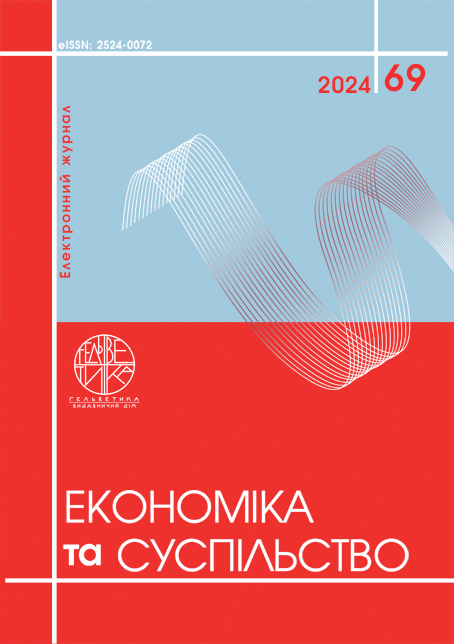АДАПТАЦІЯ PCDL-МОДЕЛІ ДО УПРАВЛІННЯ БРЕНДОМ УНІВЕРСИТЕТУ В ЦИФРОВОМУ СЕРЕДОВИЩІ
Анотація
У статті досліджуються виклики та можливості цифрової трансформації в управлінні брендами університетів через адаптацію PCDL-моделі бренд-менеджменту, розробленої Годесваром [6]. Основну увагу приділено чотирьом ключовим компонентам: позиціонуванню бренду, комунікації, реалізації брендової цінності та використанню брендової цінності. Автори пропонують інноваційний підхід, який інтегрує сучасні технології, зокрема аналітику великих даних, штучний інтелект і блокчейн, у процеси управління брендом університетів. Розроблено набір метрик для оцінки ефективності цифрових брендових стратегій, що дозволяє отримати комплексний аналіз результатів у кожному компоненті моделі. Дослідження базується на огляді сучасної літератури, теоретичних концепціях і практичних прикладах застосування цифрових підходів провідними університетами світу. Представлений підхід спрямований на підвищення конкурентоспроможності університетів, формування довіри аудиторії та ефективне реагування на динамічні зміни цифрового середовища.
Посилання
Melewar, T. C., & Akel, S. (2006). The Role of Corporate Identity in the Higher Education Sector: A Case Study. Corporate Communications: An International Journal, 10(1), 41-57. https://doi.org/10.1108/13563280510578196
Hemsley-Brown, J., & Oplatka, I. (2006). Universities in a Competitive Global Marketplace: A Systematic Review of the Literature on Higher Education Marketing. International Journal of Public Sector Management, 19(4), 316–338. https://doi.org/10.1108/09513550610669176
Pinar, M., Girard, T., & Basfirinci, C. (2020). Examining the relationship between brand equity dimensions and university brand equity: an empirical study in Turkey. International Journal of Educational Management, 34(7):1119-1141. DOI:10.1108/IJEM-08-2019-0313
Castro-Gómez, J., Sánchez-Torres, J. A., & Ortíz-Rendón, P. A. (2024). Influence of sustainability in the positioning of the university brand: Study in universities in Medellín-Colombia. Heliyon, 10(9):1-20. DOI:10.1016/j.heliyon.2024.e30569
Aaker, D. A. (1991). Managing Brand Equity: Capitalizing on the Value of a Brand Name. Free Press. DOI:10.1016/0148-2963(94)90009-4
Ghodeswar, B. (2008). Building brand identity in competitive markets: A conceptual model. Journal of Product & Brand Management, 17(1), 4-12. doi: 10.1108/10610420810856468
Kaplan, A. M., & Haenlein, M. (2010). Users of the world, unite! The challenges and opportunities of social media. Business Horizons, 53(1), 59-68.
http://dx.doi.org/10.1016/j.bushor.2009.09.003
Hudson, S., Roth, M. S., Madden, T. J., & Hudson, R. (2015). The effects of social media on emotions, brand relationship quality, and word of mouth: An empirical study of music festival attendees. Tourism Management, 47, 68-76. https://doi.org/10.1016/j.tourman.2014.09.001
Chen, H., Chiang, R. H. L., & Storey, V. C. (2012). Business Intelligence and Analytics: From Big Data to Big Impact. MIS Quarterly, 36(4), 1165-1188.
Hootsuite: Social Media Marketing and Management Tool (2023): https://www.hootsuite.com/
Melewar, T. C., & Akel, S. (2006). The Role of Corporate Identity in the Higher Education Sector: A Case Study. Corporate Communications: An International Journal, 10(1), 41-57. https://doi.org/10.1108/13563280510578196
Hemsley-Brown, J., & Oplatka, I. (2006). Universities in a Competitive Global Marketplace: A Systematic Review of the Literature on Higher Education Marketing. International Journal of Public Sector Management, 19(4), 316–338. https://doi.org/10.1108/09513550610669176
Pinar, M., Girard, T., & Basfirinci, C. (2020). Examining the relationship between brand equity dimensions and university brand equity: an empirical study in Turkey. International Journal of Educational Management, 34(7):1119-1141. DOI:10.1108/IJEM-08-2019-0313
Castro-Gómez, J., Sánchez-Torres, J. A., & Ortíz-Rendón, P. A. (2024). Influence of sustainability in the positioning of the university brand: Study in universities in Medellín-Colombia. Heliyon, 10(9):1-20. DOI:10.1016/j.heliyon.2024.e30569
Aaker, D. A. (1991). Managing Brand Equity: Capitalizing on the Value of a Brand Name. Free Press. DOI:10.1016/0148-2963(94)90009-4
Ghodeswar, B. (2008). Building brand identity in competitive markets: A conceptual model. Journal of Product & Brand Management, 17(1), 4-12. doi: 10.1108/10610420810856468
Kaplan, A. M., & Haenlein, M. (2010). Users of the world, unite! The challenges and opportunities of social media. Business Horizons, 53(1), 59-68. http://dx.doi.org/10.1016/j.bushor.2009.09.003
Hudson, S., Roth, M. S., Madden, T. J., & Hudson, R. (2015). The effects of social media on emotions, brand relationship quality, and word of mouth: An empirical study of music festival attendees. Tourism Management, 47, 68-76. https://doi.org/10.1016/j.tourman.2014.09.001
Chen, H., Chiang, R. H. L., & Storey, V. C. (2012). Business Intelligence and Analytics: From Big Data to Big Impact. MIS Quarterly, 36(4), 1165-1188.
Hootsuite: Social Media Marketing and Management Tool (2023): https://www.hootsuite.com/

Ця робота ліцензується відповідно до Creative Commons Attribution 4.0 International License.


